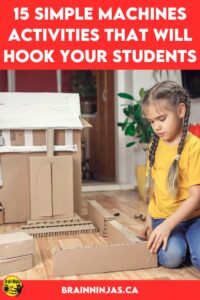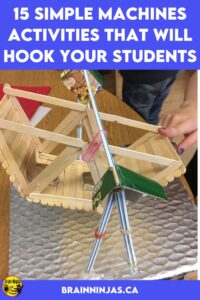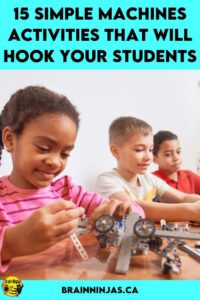
One of our favourite science units to teach is about simple machines or wheels and levers (if you teach in Alberta). We love it because it provides many opportunities for hands-on learning and can be done inside regardless of the weather. Students love to build contraptions and we can use up materials that would generally go in the recycling bin so it’s also a very low-cost science unit. Which of these activities have you tried during your science lessons?
Learn About the Simple Machines
If you are looking to plan out your whole unit in minutes, the easiest thing you can do is check out our Simple Machines Unit in our TpT Store ($USD) or our BN Shop ($CAN). It includes lesson and unit plans along with all the activities you need. Just add students and some materials to use for building.
Start With a Simple Experiment
We use this simple experiment to show students how simple machines help make work easier. You can find this free experiment in our TpT Store or BN Shop.
Create a Scavenger Hunt
Create a scavenger hunt where students have to find and identify different simple machines around the classroom or school. Provide a list of machines to look for, or challenge them to find as many as they can. You can do this before giving students definitions for the different types of simple machines or once you have taught them all six. Either way, learning to identify how different objects in their world connect to what they are learning in science helps students retain information.
Provide students with pictures or actual examples of simple machines and ask them to sort them into the six different types of simple machines (lever, pulley, wheel and axle, inclined plane, wedge, screw).
Teach Some Lessons
We have many different concepts included in our Simple Machines Lessons available in our TpT Store ($USD) or BN Shop ($CAN). The entire set of lessons includes the six simple machines, wheels and rollers, types of pulleys, types or classes of levers, contact and non-contact forces (like electrostatic and gravitational), basic drive systems and types of gears. There is also an activity about the different machines historically used by Indigenous People in Canada.
Read About Different Simple Machines

When we were trying to teach during the pandemic, we couldn’t find enough quality text to give to students to read while at home. So, the only choice we had was to write our own passages. Now we use these passages in school and made them more accessible by having both paper and digital versions. The digital version includes loose text that can be read by assistive technology. Simple Machines Reading Passages are available in our TpT Store ($USD) or BN Shop ($CAN).
Reading Comprehension Activities come with reading passages and then several activities for your Language Arts lessons. Students will work on comprehension skills in addition to word parts, conventions, and extension activities. You can learn more about how we use these activities in our Language Arts Lessons in our post Add Great Content to Your Literacy Lessons.
Indigenous Tools on TpT ($USD) or our BN Shop ($CAN)
Nature’s Machines on TpT ($USD) or our BN Shop ($CAN)
Silly Machines on TpT ($USD) or our BN Shop ($CAN)
Mechanical Watches on TpT ($USD) or our BN Shop ($CAN)
Or, you can get the whole set in a discounted bundle. Find Simple Machines Reading Comprehension Activities on TpT ($USD) or our BN Shop ($CAN).
Complete a Collaborative Poster
If you’re looking for a creative way to introduce the six simple machines, try a collaborative poster. Each student colours a piece and then all the pieces are reassembled into one poster that you can hang in your classroom to reference while teaching the rest of the unit. Our posters come in 18, 24, or 36 piece sets and include a follow-up activity. Find our Simple Machines Collaborative Poster in our TpT Store ($USD) or BN Shop ($CAN).
Invite a Guest Speaker
Invite a local engineer or mechanic to speak to the class about how simple machines are used in their work. You might have parents or guardians that would love to volunteer their time and bring in some tools to show students how they work.
Get Some Hands-On Experience
Build a Pulley System

Provide materials such as string, a small bucket, and a pulley and challenge students to build a pulley system. Have them experiment with different weights and heights to see how the pulley system affects their ability to lift objects.
Spools, dowels, or even a string tied to a paper towel roll can work as a pulley. You don’t need actual pulleys. In fact, one activity for your students could be designing the actual parts of the pulley with basic and available classroom materials.
We have several different activities similar to this in our STEM Challenges in our TpT Store ($USD) or BN Shop ($CAN).
Build a Catapult
Catapults are a fun way to learn about levers and how they can be used to create force. Using materials such as popsicle sticks, rubber bands, and plastic spoons are usually accessible and reusable. Challenge students to build a catapult that can toss small objects like a piece of eraser or a marshmallow.
Find more activities like this in our STEM Challenges in our TpT Store ($USD) or BN Shop ($CAN).
Race Objects Down an Inclined Plane

Set up an inclined plane using a board or a piece of cardboard and have students race different objects down the slope. Encourage them to experiment with different angles and objects to see how it affects their speed.
Students will need to know how to measure using a measuring tape (unless you have lots of meter sticks). We taped our meter sticks down the hall so they were out of the way and students wouldn’t accidentally kick them.
Have students build their inclined plane with a shallow slope. They can roll the same object down the slope and measure it three times in a row to get their results. Record these results.
Adjust the slope so it is steeper. Repeat the process by having students record their observations (measurements) three times in a row.
Finally, adjust the slope so it is very steep. Repeat the process and measure the results.
Ask students to draw a conclusion about how the steepness of the inclined plane impacts the distance the object travels.
Use the scientific method to track your results with our free experiment pages.
Build a Simple Machine Model
Challenge students to build a model of one or more simple machines using cardboard, straws, and other materials. Have them explain how their model works and what it is used for. Students could create a slide in a presentation along with photographs of real-world examples.
We have a version of this activity that uses cardstock in our Simple Machines Lessons available in our TpT Store ($USD) or BN Shop ($CAN).
Build a Rube Goldberg Machine
Rube Goldberg machines are elaborate contraptions that use a series of simple machines to perform a task. Challenge students to build a Rube Goldberg machine using at least three different simple machines. There are lots of videos online that can inspire your students.
If your students are really interested, there are even contests held through rubegoldberg.org
Design and Build a Carnival Attraction
We planned this entire activity out for you in our Design a Carnival Attraction activity available in our TpT Store ($USD) or BN Shop ($CAN). It includes planning pages, a marking guide and student reflection pages that are ready to use. This is our absolute favourite activity from our whole unit and we use it as a final assessment (and it keeps the kids busy working for a whole week).
Review What Students Have Learned

Play Charades
Write different simple machines on slips of paper and have students act out the machines for their classmates to guess. When students call out the correctly guessed word, give them a bonus point if they can name which simple machine it is. Give even more points if they can specify the class of lever or the type of pulley.
Play a Review Game
These questions and answers are linked to each other so students can check their own understanding. It comes with an editable slide so you can add your own questions and answers. Simple Machines Interactive Review Game is available in our TpT Store ($USD) or BN Shop ($CAN).
Use Task Cards
Our task cards include a paper version, a Google Slides version and a Google Forms version (which is self-marking). This means they can be used to practice or for assessment. Simple Machines Task Cards Review are available in our TpT Store ($USD) or BN Shop ($CAN). This set is about the machines and includes questions about gears, forces and other general information.
Which Machine is This? Task Cards are available in our TpT Store ($USD) or BN Shop ($CAN). This set is only about the six simple machines.
What Other Topics Are You Teaching During Science?
You might find some of our other science posts helpful.
How to Shock Your Students With Engaging Electricity Lessons
How to Escalate Your Chemistry Experiments
10 Engaging Weather Lessons All in One Place
How to Grow a Healthy Classroom with Plants
How to Learn About Wetlands Without A Pond
Do you have some other favourite science activities? Tell us about them in the comments below.







